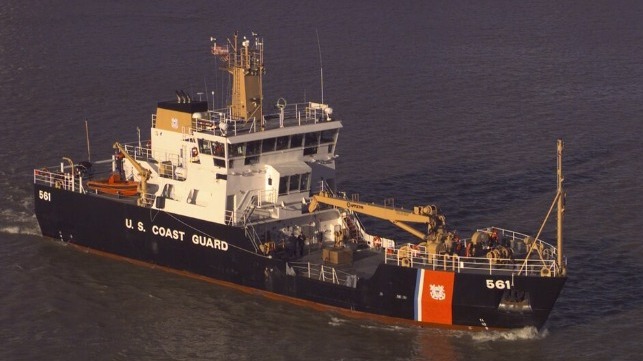Posted on 26 January 2022 22:17 by
The Maritime Executive
Newly released video shows a never-before-seen 2020 collision between an OSV and a U.S. Coast Guard lifeguard at Sabine Pass, shortly after Hurricane Delta hit.
On October 11, 2020, two days after Delta made landfall in Louisiana, the U.S. Coast Guard buoy tender Harry Claiborne transited from Galveston to Sabine Pass, where her crew checked and reset buoys along the channel. Around 3:25 p.m., Claiborne was working on buoy 27 near the entrance to the channel, and she was in DP hold mode with the bow pointed outward. Her crew had the buoy on deck and they were pulling on her chain to determine the location of her sinker, as had been reported out of station.
OSV Bowtruckle 33 exited the channel, headed for an offshore platform. Her captain was at the helm and he contacted Harry Claiborne on VHF to make overtaking arrangements, offering to overtake on Claiborne’s starboard. Given the Claiborne’s location – on the buoy – this would put Bowtruckle 33 outside the navigation channel, closer to shore.
Claiborne’s captain responded to the call and, after consulting with his bridge team – who advised against him – he agreed to Bowtruckle 33’s proposed overrun arrangement.
Shortly after, a crew member on deck radioed that the collision was imminent. The captain warned the crew to prepare for impact and began ringing five shorts as a warning. In a few seconds, Bowtruckle 33 hit At Harry Claiborne’s back.
A damage assessment revealed a 12-inch hole about eight feet above the waterline, with “serious transom dents and deformations,” the captain said in an after-action report. No flooding was reported, the propulsion system was working and the DP system automatically returned the vessel to its position as before. As a precaution, the CO ordered the crew to cast off the port anchor and stow the deck load. In accordance with Coast Guard damage control standards, his DC crew quickly plugged the hole and shored it up with steel.
During this time, Bowtruckle 33 had run aground at the edge of the channel, about 40 meters off Claiborne’s starboard side. Over VHF, the CO heard Bowtruckle 33’s captain telling the VTS operator that he was trying to refloat his vessel. After pumping the ballast, Bowtruckle 33 floated, then drifted towards Harry Claiborne on a collision course. Claiborne’s commanding officer ordered the deployment of fenders on the starboard quarter to reduce damage, and shortly thereafter the Bowtruckle 33 struck again, making another small dent in the hull of the buoy.
After the Bowtruckle 33 was clear and past, the Claiborne completed resetting buoy 27 and departed the station. Once underway, her engineers reported a harsh knocking noise coming from the port azipod. The bridge team secured the port engine and returned to port for repairs.
After the accident, the captain of Bowtruckle 33 told National Transportation Safety Board investigators he believed the stern of his vessel had begun to run aground, resulting in a loss of control. He said that in his experience there was usually plenty of water around buoy 27, and he believed Harry Claiborne’s crew should have told him to cross to the other side if the buoy was closer to shore than it should be.
“I thought they were moving the buoy, because when I asked him for a whistle [starboard side overtaking arrangement], he accepted, then I asked him another time, he accepted. So I just assumed he knew how deep the water was, and that’s where I was good at going through it,” said Captain Richard Lege, the captain of Bowtruckle 33. “Given that the buoys have been moved and everything and he’s been working on the buoys, the way it’s been set up, I was like, okay, let me see, you know. And I was never told that the water – the depth was shallow or maybe you want to cross to the other side, you know.”

